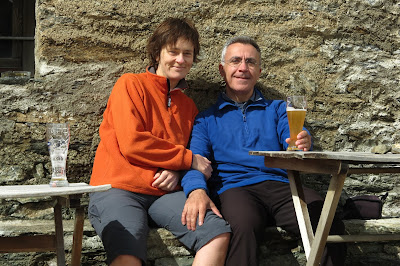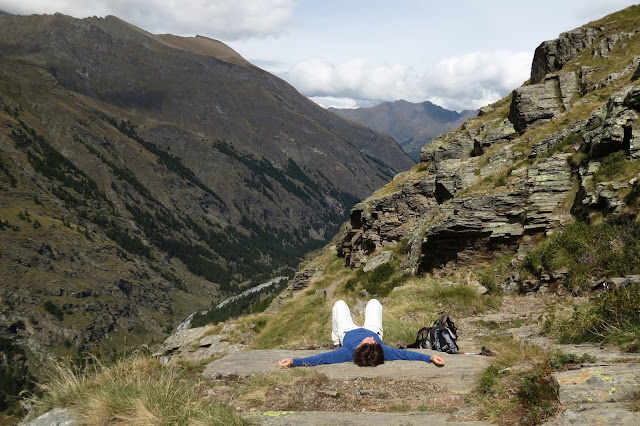Let's say 10km a week, over a period of nearly 20 years... So maybe 10,000? And how many of those must have been in the Alps. You might think we would be searching for a different type of scenery for a week's holiday. But the Alps are vast. And the better we know them, the more nuanced our appreciation of the differences, region to region, has been.
Gran Paradiso National Park is a short drive, for Juan, over the St Bernard pass and via the elegant town of Aosta. Following on from our Dolomites week in July we were once again surprised to find an Italian geo-political quirk: Aosta valley was part of the kingdom of Savoy until 1861 and has some similarities with the Tyrol – Italianisation under the fascist regime in the 1920s. But in Aosta valley there was a greater willingness to embrace Italian nationality and, although French is widely spoken (our airbnb hostess told us that she still speaks the patois she grew up with, which is the same languedoc spoken in Provence), and much of the signing is bi-lingual, it feels Italian. Chic shops sell classy charcuterie and the sweet smell of chocolate wafts from the many confiseria.
As we strolled through Aosta it was curious to think that the population – to us so obviously Italian with their lime-green-pink-black trainers, or tight-fitting shiny suits – has been Italian for less than a century. But, looking at a map, one could wonder how on earth this corner of the Alps could ever have been ruled from France, with passes into the French Vanoise (where we have walked on several occasions) open only four months of the year.
We had planned the week as a two-day trek walking east along the long-distance Alta Via 2, from Chardonnay to Cogne, followed by 4 days based in Cogne. Leaving the car at Cogne, and getting to Chardonnay for the start of the walk, was a tad complicated – 3 buses with lengthy waits in between. Communication with the bus drivers was rudimentary – in pidgin French. But all went well, and the last stretch of the journey was spectacular, up a crazy switchback road with birds-eye views over the many tiny hamlets, their stone tiles reminiscent of Vanoise architecture, only a stone’s throw away.
It was dusk as we arrived at our hotel at Chardonnay, a funky building with dated decor. Supper was basic, an exercise in how many carbs you could pack onto one meal: gnocchi and bread followed (for Juan) by beef and chips. Afterwards, as we waddled around the village trying to digest, the rain predicted for the first day of our walk had already arrived.
At breakfast the following morning the bread we had rejected for supper resurfaced. Ah well, waste not, want not. We left the hotel in steady rain, a novel experience, as, during our years in France, we have become fair-weather walkers. With no waterproof trousers and – in my case – very inadequate footwear we were ill equipped for the conditions. After 2 hours we were drenched.
Never was a rifugio more welcome than Dondena. Heaven was drying out beside a wood-burning stove. And then – despite the forecast – seeing the clouds part and sun reappear.
An hour or so later we arrived at Miserin rifugio, photogenically situated adjacent to the lake of the same name, and – bizarrely – a massive church, Notre Dame de la Niège, built on the site of a medieval miracle statue.
The rifugio was memorable for its shower (yes, luxury) cubicles with transparent walls! Luckily my neighbour was a familiar Spaniard.
Back outside, it was just warm enough to enjoy a beer on the decking, and stroll around the lake, before rain returned.
As we waited for supper Juan humiliated me at Scrabble, less phased than me by the preponderance of "i"s and "a"s in the Italian version. Supper was good but an impossible calorie load: a huge plate of cheesy pasta followed by sausage stew and fried potatoes. We could barely peck at the latter.
The next morning we walked against the flow of runners competing in the “Tor des Géants”, the 340km, 24,000m+ ascent endurance trail. During a week runners run up and over a series of punishing mountain passes, overnighting and eating in large tents erected in the participating villages. Strongly male-dominated, most of the runners we passed looked pretty wrecked. It's hard to imagine the level of fitness one would need to make this anything other than a hellish act of stoicism. We learned that two French iron men were leading the way... And that many others had been slowed by the snow that had fallen over one of the passes near the beginning of the route at Courmayeur.
We walked over the Fenêtre de Champorcher and started the 1200m descent. First stop was the rifugio at Sogno di Berdzé, where we tanked up with cake and capucchino.
Until this point the scenery hadn't been very different from our regular stamping ground, the austere and majestic Oisans. But as we descended the Vallon de Urtier, entering Gran Paradiso N.P., the treeless rock-strewn pastures were replaced by steep-sloped larch forest, massive boulders, granite slabs, cliffs and waterfalls, fast-flowing rivers, views of glaciers. Gorgeous.
The scale of the landscape was different, too – the peaks, at 3000+m, higher than "our" Alps, but without the assistance of the cable-car network you find in Switzerland. So our descent was hard work. At one point we thought we'd hit the valley floor but it turned out to be a hanging valley, still 400m above our destination, Lillaz.
From Lillaz we hitched the last 3km to Cogne, a delightful village well established with the well-heeled middle aged. Window boxes adorn huge turn-of-the century hotels, with well tended gardens giving grandiose views down the valley. The sun loungers give a clue as to how tourists must spend their time in the high season. With virtually no ski infrastructure, and no mountain-bike trails or white-water opportunities, this isn't the place for those seeking an adrenalin rush. But, as an idyllic base for walking and high-level bivvy and rifugio sleep outs, where agriculture gives an authentic feel, and where there are endless gastronomic eating, Cogne is hard to rival.
We had taken advantage of a "4 for the price of 3" deal, and booked at the Madonnina hotel. The clientele was entirely Italian, mostly in the sixties, with one younger group – the women trotting around the dining room in 3-inch stilettos.
Snooty though I am about schmoozing it, I think I may be converted to the 3-star experience, in particular the pleasures of the hydro-massage-hammam at the end of a long walk. (Even if, to quote Juan, we wouldn't have positively chosen the couple with whom we shared the outdoor jacuzzi.) And as for the breakfast... for four days we indulged in yoghurt-seeds-stewed-fruit, scrambled-eggs-local-bacon and the full range of Italian pasticceria... eating until we could eat no more, and skipping lunch.
From the hotel we did day walks of various lengths, depending on the amount of rain.
Valmontey village to the top of Valnontey valley, via the ruined hamlet of Money, with Glacier Grand and Glacier de la Tribulation ahead
Lillaz waterfalls
Lago de Loie – in conditions so wet that we didn't even manage a photo of the lake!
After four days of Simon & Garfunkel covers, Brahms lullabies and Tina Turner it was time to move – to the spartan refuge conditions we are used to. We walked up to Rifugio Vittorio Sella, and from there to Col Rousse, impressing ourselves with how manageable the 1500+m ascent seemed. Along the way we saw more marmots than we’ve seen all summer, and numerous view of chamois and bouquetin. From the col we had fabulous views of Gran Paradiso peak, and the glaciers all around Valnontey valley.
We dropped down to the rifugio for the night. It was huge (sleeps 200 – those were the days, when refuges could attract such numbers) and old fashioned: squat toilets and no showers, but a friendly guardienne and a great evening meal: minestrone soup, wild boar stew with fried potatoes, and apple strudel.
The following morning – the last day of the holiday – the sky was clear and blue for our walk back down to Valnontey. How it "should" have been, but we were happy to have seen the mountains in all weathers – the rain, after all, the reason for those sumptuous snow-dusted peaks.
Down in the valley we were in time for a strange annual spectacle: “La bataille des Reines”, which takes place in a different village each month. The event plays on the natural bellicose instincts of certain Alpine breeds, such as the Valle d'Aosta pie noire, which by fighting, determine the hierarchy within the herd. Apparently the cows don’t damage themselves, it’s more heavy-duty pushing than goring. But who would have believed girls could be so bolshy…
So thank you, feet and thank you, toes, for allowing me to enjoy so much astounding scenery. And thank you, Juan for this week, and the countless good times we’ve had in the mountains together. This blog is not the place to describe why this was more than the end of a holiday, and of summer. Or why I must, with a heavy heart, say "over and out for now".














































